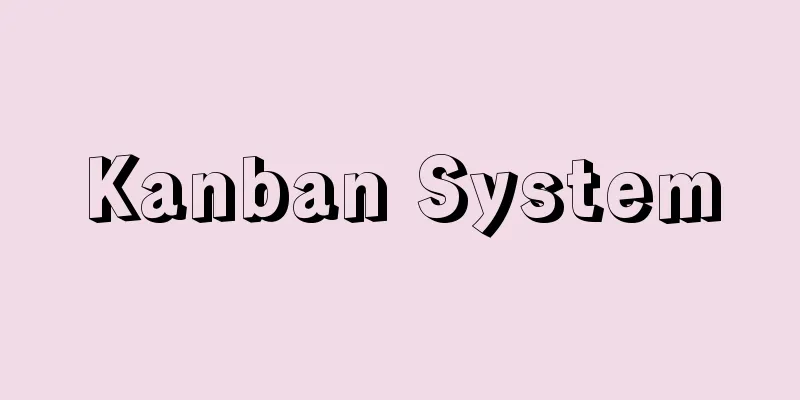Kanban System

|
When the Koromo Plant was completed in 1938, Kiichiro Toyoda, founder of Toyota Motor Corporation, adopted a factory layout in which each part manufacturing line was interconnected so that each part manufacturing line could be synchronized to supply parts to the final assembly line, and advocated and tried out just-in-time production, which produces only what is needed, when it is needed, and in the amount needed. However, the trial was discontinued due to the tendency to focus on military production. In the 1950s, just-in-time production was tried again to avoid producing wasteful products when funds and materials were scarce. As a tool to realize this, the "kanban" was invented and put into practical use in the 1960s. The downstream process would go to the upstream process to pick up the required number of parts indicated on the "kanban" that was removed when the parts were used, and the upstream process would produce the required number of parts indicated on the "kanban" that was removed when the parts were picked up. In this way, the "kanban" came to be widely used as a tool for issuing transport instructions for downstream processes and production instructions for upstream processes. In just-in-time production, "production by flow" is important. When producing many different types of parts on the same line, it is necessary to average the number of parts produced per unit time in order to produce parts that have been taken over to the next process without delay. For this reason, in 1971, a rotary-type assembly machine was adopted in an engine factory where many different models were assembled. A model display plate was placed on a rotary device, and as the plate rotated, the plate was projected onto a television in sequence, indicating the model to be assembled online. Location: Commemorative Museum of Industry and Technology (4-1-35 Noritake-shinmachi, Nishi-ku, Nagoya, Aichi 451-0051) Year of production: 1960 Manufacturer: Toyota Motor Corporation Material TypeReproduction Current display (static) / Public Model kanban Company Name: Toyota Motor Corporation Year of production : 1960 Other details : Department/section name: Technology Management Department (Telephone number) 0565-23-6345;Name of person filling out: Kazuo Osuga;Related industry association: Society of Automotive Engineers of Japan;1.Name of material: Production method;2.Location (organization name): Industrial and Technology Memorial Museum;2.Location (address): 4-1-35 Noritake-shinmachi, Nishi-ku, Nagoya, Aichi 451-0051;3.Administrative owner (Telephone number): 052-551-6115;4.Person in charge (affiliation): Industrial and Technology Memorial Museum;Type of material: Reproduction;Current status: Exhibition/static;Public/private: Public; Source: Society of Automotive Engineers of Japan, Inc. Information on the 240 Best Japanese Automotive Technologies |
|
トヨタ自動車の創業者の豊田喜一郎は、1938年に完成した挙母工場の建設に際し、各部品製造ラインが最終組立ラインに同期化して部品を供給できるように、各ラインが相互に連結した工場レイアウトを採用し、その工場で必要なものを、必要なときに、必要なだけ生産するジャスト・イン・タイム生産を提唱して試行した。しかし、その試みは、軍需生産に傾斜するなどにより試行は中断された。1950年代に、資金や材料が乏しいなかでムダなものを生産しないようにするためジャスト・イン・タイム生産が改めて試行された。それを実現する道具として1960年代に「かんばん」が考案され、実用化された。後工程は、部品使用時に外した「かんばん」に表示された必要数を前工程に引き取りに行き、前工程は部品引き取り時に外した「かんばん」に表示された必要数を生産するというように、「かんばん」は後工程の運搬指示と前工程の生産指示の道具として広く利用されるようになった。ジャスト・イン・タイム生産では、「流れによる生産」が大切である。多種類の部品を同一ラインで生産する場合、後工程に引き取られた部品を遅滞なく生産するために、単位時間毎の生産個数を平均化する必要がある。そのため1971年に、多機種を組み付けるエンジン工場で、機種表示プレートをロータリー装置に配置し、回転により順次プレートをテレビに写してオンラインで組み付け機種を指示するロータリー式仕掛機が採用された。保管場所産業技術記念館 (〒451-0051 愛知県名古屋市西区則武新町4丁目1番35号) 製作(製造)年1960 製作者(社)トヨタ自動車工業株式会社 資料の種類複製 現状展示(静態)・公開 型式かんばん 会社名トヨタ自動車株式会社 製作年1960 その他事項記入部課名:技術管理部 (電話番号)0565-23-6345;記入者名:大須賀 和男;関連工業会:社団法人自動車技術会;1.資料名称:生産方式;2.所在地(組織名称):産業技術記念館;2.所在地(住所):〒451-0051 愛知県名古屋市西区則武新町4丁目1番35号;3.管理所有者(電話番号):052-551-6115;4.担当者(所属):産業技術記念館;資料の種類:複製;現状:展示・静態;公開・非公開の別:公開; 出典 社団法人自動車技術会日本の自動車技術240選について 情報 |
<<: Rock Mass - I'll do my best
>>: Official German Vocabulary - Kanban Doitsutangohen
Recommend
Hostage - Hitojichi
A person given to the other side as a guarantee f...
Tsurui [village] - Tsurui
A village in Akan District, eastern Hokkaido. Loca...
zeaxanthin
...The color of physalis, chili peppers, egg yolk...
Functionalism
In contrast to constructivism, or structural psych...
Animal Memorial Service
This is a ceremony to mourn and hold memorial ser...
Turk - Turk (English spelling)
A nomadic state established by the Turkic Ashinas ...
Julius Kambarage Nyerere
Tanzanian politician and first president. Born in...
Karloff, B.
…The monster in the film was depicted as a kind o...
Hutu
...They are also called Watutsi or Tussi. They ar...
Voltage regulator
A device that adjusts the voltage to a specified ...
Commercial Revolution
From the 11th century to the 13th century, especi...
Numbers - Numbers
〘noun〙① Something that is numerous. Also, somethin...
Tosha Ashifune (Tosharosen) - Tosharosen
The name of the head of a Kabuki musical instrumen...
Lady Amherst's pheasant (English spelling: Chrysolophus amherstiae)
Order Phasianidae, family Phasianidae. Males are 1...
Carpe rosas (English spelling) carperosas
…The motto “carpe diem” (seize the moment, enjoy ...









